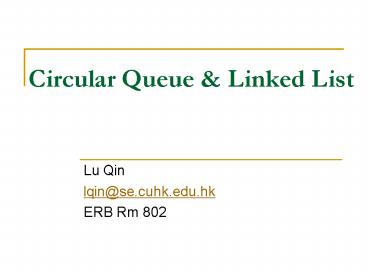Circular Queue PowerPoint PPT Presentation
1 / 14
Title: Circular Queue
1
Circular Queue Linked List
- Lu Qin
- lqin_at_se.cuhk.edu.hk
- ERB Rm 802
2
Circular Queue
- Use Linear Array to implement a queue.
- Waste of memory The deleted elements can not be
re-used. - Solution to use circular queue.
- Two implementations
- Using n-1 space.
- Using n space full tag
3
Implementation of Circular queue with (n-1) space
used
- Create(Q)
- Q Array0n-1
- front rear 0 //initialize
- Enqueue(item, Q) ?Queue
- begin
- rear (rear1) mod n //rear moves
forward - if rear front
- QueueFull // Queue is full.
- rear rear-1 mod n // rear back
to the previous position - else
- Qrearitem
- end
? R (R1) mod n
4
Implementation of Circular queue with (n-1) space
used
- Dequeue(Q) ?item
- begin
- if frontrear
- QueueEmpty
- else
- front (front1) mod n
- item Qfront
- end
- end
- Note only (n-1 ) space used
X
X
X
X
X
X
X
X
X
X
R
X
X
F
5
Implementation of Circular Queue with n space used
- A parameter Tag is introduced to help to make
sure the queue is Empty or Full - Boolean
- If Tag True, combined with other conditions
queue is Full - If Tag False, combined with other conditions
queue is Null - Tag can determine the states of the queue
solely!
6
Implementation of Circular Queue with n space used
- Create(Q)
- Q Array0n-1
- front rear int 0
- Tag Boolean False
- Enqueue(item, Q) ?Queue
- begin
- if (rear front Tag 1)
- QueueFull
- else begin
- rear (rear1) mod n //rear
moves forward - Qrearitem
- if (rearfront)
- Tag1
- end
- end
7
Implementation of Circular Queue with n space used
- Dequeue(Q) ?item
- begin
- if (FrontRear and Tag0)
- QueueEmpty
- else begin
- Front (Front1) mod n
- item QFront
- if (FrontRear)
- Tag0
- end
- end
- Note n space can be used
X
X
X
X
X
X
X
X
X
X
R
X
X
F
8
List
- A list provides a way to organize data
lists are sequential
A to-do list.
not accidental
9
Linked list
- Def A sequence composed of many Nodes, each Node
is composed of two parts Data, Link (or Pointer
point to another node). - A node in a linked list is a structure that has
at least two fields - Data
- The data part holds the useful information, the
data to be processed. - Link
- Used to chain the data together. It contains a
pointer that identifies the next element in the
list. - A pointer variable identifies the first element
in the list. The name of the list is the same as
the name of this pointer variable.
10
Linked List, array, stack, queue
- Comparison with Array
- Arrays are easy to create and use, but they are
inefficient when sequenced data need to be
inserted or delete. - The linked list efficiently handles insertions
and deletions, but it is inefficient for search
and retrieval. - Comparison with queue and stack
- - Linked List Data can be inserted and deleted
anywhere and there are no restrictions on the
operations that can be used to process the list - - Queue and Stack Data can only be added or
deleted at the ends of the structure and
processing is restricted to operations on the
data at the ends of the list.
11
Note different representations of a node
- If the node have its own name
- x.Dataaccess to the data of node x
- x.Linkaccess to the link of node x
- If node have no name,but pointed by pointer t
- t?Data access to the data of node pointed by
t - t ? Link access to the link of node pointed by
t
12
- Ex
- Print(p?Data) 20
- Print((p?Link)?Data) 80
- r is equivalent to q?Link or, (p?link)?link
13
Linked List Properties
- Properties of Linked list
- Nodes may not stored in serial Memory
- One of the attributes of a linked list is that
there is not a physical relationship between the
nodes that is, they are not stored contiguously. - Data Type of different Nodes can be different
- Easy to Insert/Delete Node
- It is not necessary to shift elements of a
linked list to make room for a new element or to
delete an element.
14
Thanks

